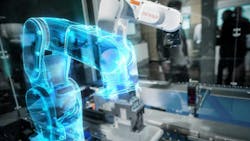The emergence of the metaverse and Web 3.0 is adding to the possibilities around augmented and virtual reality (AR/VR), simulation, and digital twin technologies. But it’s also creating some confusion given the multiple definitions circulating around each technology.
While the metaverse and Web 3.0 are something to keep an eye on, industrial use of these technologies is still likely years away from being a practical reality for use in most production operations. But simulation and digital twin technologies are here today and have been implemented by manufacturers and processors in multiple industry verticals. To answer a reader question about how digital twins work in practice in industry, we connected with Dan Riley, analytics manager with system integrator Interstates, for a recent episode of the “Automation World Gets Your Questions Answered” podcast series.
To begin, we asked Dan to explain the digital twin concept to help our listeners better understand how it can be applied to devices and machines as well as an entire production operation.
“Generally speaking, a digital twin is a digital representation of a physical object or process,” Riley said. “At its most basic level, a digital twin is comprehensive operational dashboard [of the device, machine, or factory it is representing]. Something that most manufacturers have in their plants—an HMI—could be seen as a basic digital twin, in a sense, because it is the digital representation of their process [that relies on real-time data inputs and outputs].”
Because of its ability to accurately reflect real-time operating conditions, digital twin technology can be used in research and development as well as testing and commissioning, Riley said. “OEMs and process engineering firms are using the technology to test and improve physical aspects of production like temperature controls and flow rates.”
Level of difficulty
Because digital twin technology can be so widely applied—from individual devices to entire plants, we asked Riley to discuss the difficulty of implementing it for a typical manufacturer.
These core, pre-implementation steps mean that digital twin technology is not an entry-level digitization use case, said Riley. “It is an advanced use case that requires you to have a plan in place and data champions at key layers in the organization to get the most value out of a digital twin.”
He noted that, depending on the complexity of your digital twin implementation, you'll want to have a reliable plant Wi-Fi network if you want to deploy headsets to operators or maintenance personnel to access the digital twin hands free.
As daunting as the selection and implementation of digital twins may be, Riley said manufacturers of all sizes are doing it with good success. “We work with plenty of mid-tier manufacturers using digital twin technology, though it is still mostly larger manufacturers using it.” He said he expects the added AR/VR capabilities to remain in the realm of larger manufacturers for the foreseeable future, but digital twin dashboard technology is well within the reach of mid-tier manufacturers.
Cost factors
Before getting to the application aspects of the digital twin, there are, of course, cost considerations that must be considered. These costs will vary widely depending on what vendor you’re working with and how extensive your use of the digital twin will be.
To anticipate these costs factors, Riley says its important to recognize that there are two groups of cost associated with digital twin technology. “First there will be the platform cost that's going to enable you to do the digital twin. The cost of the platform will be affected by what you plan to do with it; for example, if you want to have AR/VR capabilities, that platform is going to be more expensive than a digital twin technology that [only] provides a comprehensive dashboard.”
Riley says you can save costs on digital twin technology by first making an investment in preparing your data and having it well understood across your operations.
Leaders relevant to this article:



